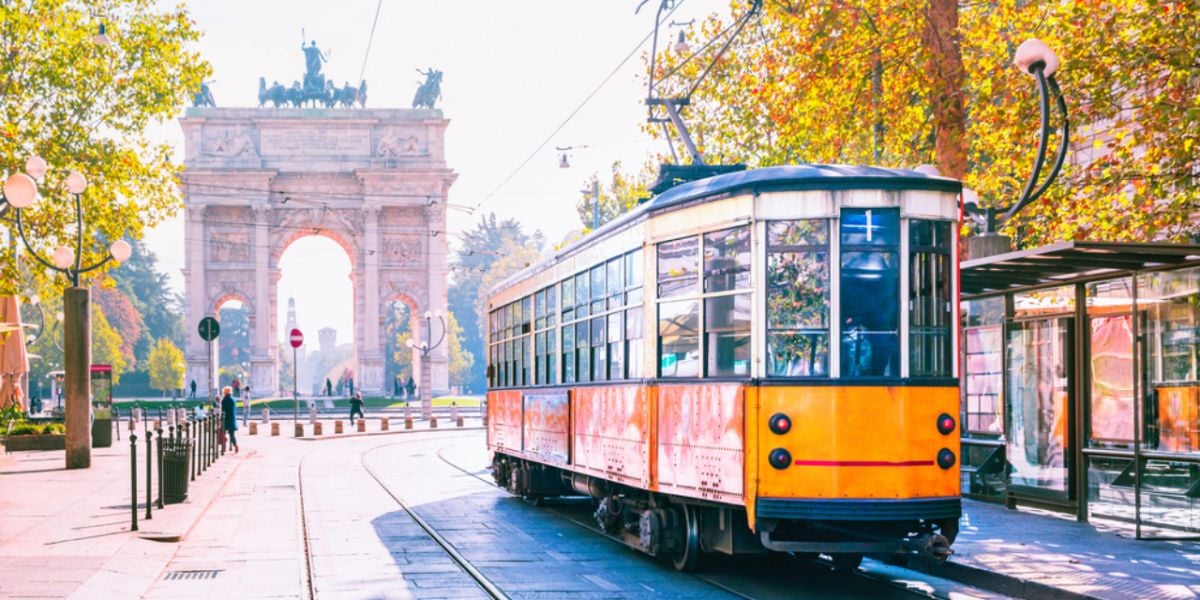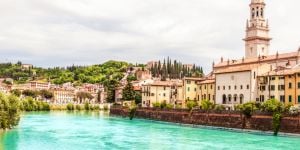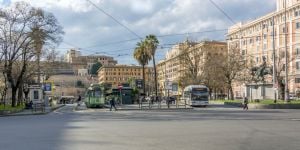
As an expatriate in Italy, you will naturally need to travel on a daily basis. It's interesting to note that Italians travel a lot out of necessity, for example, to get to work, but also and above all,for leisure. Here is an overview of the different means of transport available in Italy.
Traveling by train in Italy
Italy operates a reasonably priced, reliable and efficient rail network that covers the whole country and connects most major cities. There are three different types of trains in Italy, which vary in price and speed.
Frecce: these high-speed trains operate only between major cities. Advance booking of seats is recommended, and prices are significantly higher than the Intercity and Regionali alternatives. There are three different types of Frecce trains:
- Frecciarossa (which connects Turin, Milan, Bologna, Rome, Naples and Salerno, and reaches a speed of 360 km/h) runs only on the high-speed rail network.
- Frecciargento (which connects Rome, Venice, Verona, Bari, Lamezia Terme, and Reggio Calabria, and reaches a speed of 250 km/h). The Frecciargento runs on the high-speed network but also on traditional lines.
- Frecciabianca (which connects Milan, Venice, Udine, Trieste, Genoa, Rome, Bari and Lecce, and reaches a speed of 200 km/h). This train runs on traditional lines outside the high-speed network.
Intercity: These relatively fast trains run throughout the country and stop in most towns and cities. First- and second-class service is available.
Regionale: These local trains often run during school and office hours. Fares are generally reasonable and booking is not necessary.
The Italian railway system is controlled and regulated by Trenitalia, whose website is available in several languages. Note that when booking, you will need to indicate the Italian name of your destination, for example, Roma Termini for Rome. ItaliaRail also offers a multilingual service for those wishing to book tickets online.
There is also a high-speed train service that covers Italy's largest cities: Italo, which has been active since 2012. It is a competitor to Trenitalia owned by the private company Nuovo Trasporto Viaggiatori (NTV). Currently widely used for travel in Italy, it has interesting offers all year round.
There are also other private rail companies, such as Ente Autonomo Volturno, which allow local travel between Naples, Pompeii and the Amalfi Coast.
Important:
You must always validate your ticket before boarding your train. To do so, simply locate a green and white terminal (usually at the entrance to the departure track of your train, the binario), insert your ticket, and it will print the time and date of use of the ticket. Please note that failure to comply with this rule will result in a severe fine.
Traveling by bus in Italy
The bus is a very common means of transport in Italy. It is reliable and economical and allows you to travel to many cities that are not served by train. Oraria Autobus provides useful information on coach timetables in each region. Check My Bus is an excellent resource for searching for buses operating in specific cities and provinces.
Good to know:
It is strongly recommended that you buy your bus ticket before the day of departure. This can be done online, at a tabaccaio (tobacco bar), a newspaper vendor, or at vending machines in metro stations.
Important:
Make sure you validate your ticket when you get on the bus or you may be fined between 50 and 110 euros.
Many bus companies also offer air conditioning and free Wi-Fi. Major national companies in Italy include Marino Autolinee (connecting Naples, Bari, Bologna, Genoa, Milan, Padua, Parma, Turin and Venice) and Itabus. In addition, some multinational coach companies, such as FlixBus and Omio, offer low-cost coach routes between large and small cities.
Driving in Italy
If you prefer to travel independently, or if you plan to live in a small town or rural area, a car may be the most practical option. While driving in Italy has a rather folkloric image, the highway code is generally respected, and as long as you have a valid driver's license, everything will be fine. European driving licenses are recognized in Italy, but if you have an international driving license you will have to exchange it for an Italian one. Keep in mind that Italy has a point-based driver's license.
Italy has an extensive and well-connected road network made up of motorways (Autostrade), important state roads such as motorways (Strade Statali), regional roads (Strade regionali), provincial roads (Strade provinciali) and local roads (Strade Locali).
Please note that motorways in Italy are subject to a charge, and if you wish to avoid queuing at toll booths, especially at weekends and during holiday periods, it is advisable to take out a pass, the Telepass. For more details on traffic conditions, routes and tolls, visit autostrade.it.
Important:
The Zona Traffico Limitato (ZTL), specific to city centers and historical centers, is closed to passenger cars due to the narrow streets and lack of parking space. Be careful, though. Usually, signs indicate the beginning of the ZTL and are equipped with surveillance cameras that record license plates, which means that non-compliance can lead to fines.
In some cities, such as Milan, there are different "rings", which limit cars' access to the city center in order to limit pollution. Area B covers a large part of the city of Milan and prohibits access to the most polluting vehicles (for example, Euro 2 petrol and Euro 5 diesel cars) and to vehicles exceeding 12 meters in length. Area C, on the other hand, coincides with the ZTL in the historic center and is only accessible on payment of a daily ticket. It is in force from Monday to Friday, from 7.30 am to 7.30 pm.
Car-sharing services in Italy
If you drive, you can sign up for car-sharing services such as Enjoy, ShareNow, or Share'ngo, available in major cities such as Rome, Milan and Turin.
Two-wheelers in Italy
Driving in Italy also has drawbacks. Traffic, especially in the big cities, can be disorientating, and finding a parking space can be restrictive and frustrating. To counter these issues, many Italians and expats travel by scooter or motorbike to weave through traffic and narrow roads. However, this requires a certain amount of skill, given the traffic density.
To drive a two-wheeler in Italy, you must be at least 14 years old, attend a driving school and pass a practical test.
Cycling in Italy
Bicycles are also very popular, especially in the medium-sized cities of northern Italy, such as Emilia-Romagna (Ferrara, Modena, etc.) but also Veneto, and are an integral part of the Italian way of life. One of the benefits of cycling is that it allows you to visit many historical sites and other attractions without the inconvenience of a car. You will find bicycle rental/repair shops in all Italian cities.
Good to know:
Not all cities have cycling lanes, or very few, as in Rome. In recent years, however, Milan has transformed many roads by creating cycling paths. In addition, to encourage residents to use non-polluting means of transport, the Mobility Department of the Municipality of Milan has launched a call for tenders in 2022 for companies and residents to apply for a subsidy for the purchase of a low environmental impact vehicle in exchange for scrapping their polluting vehicle.
Public transport in Italy
If you live in a large city such as Milan or Rome, public transport such as the metro is generally the best way to get from one point to another in the city center and parts of the suburbs.
In Milan especially, the network is particularly well-served, and a large number of metro lines take you to the outskirts of the city, turning into surface trains outside the urban area. The transport company ATM, which is responsible for the development and maintenance of the transport network, also provides bus and tram lines.
In Rome, the network responsible for public transport is ATAC.
Taxis in Italy
Taking a taxi is sometimes unavoidable, especially if you have just arrived in Italy. Whenever possible, hire a taxi from an official taxi stand or call the most popular taxi companies.
Be aware that unregistered taxis operate a notorious service in Italy, with high prices and hidden charges.
Also, most taxis do not accept payment cards, so bring cash. This is much less the case in Milan, where most vehicles are equipped with a payment terminal. However, be sure to check this before booking your journey.
Unless you are traveling a long distance, most taxi drivers do not give a fixed fare in advance. In addition, most cities have pre-established rates set by their authorities, which are non-negotiable.
However, it is possible to enjoy a taxi service with a regulated application and fixed fares with the possibility of paying directly via this application without the risk of unpleasant surprises at the end of the journey. FreeNow is one of them, but you can also download the AppTaxi.
Good to know:
At the moment, Uber operates in Rome, Milan, Bologna, Turin, Florence, Naples, Palermo and Catania. Unlike traditional taxis, the service is not metered, nor does it have a basic fare. The cost of the journey depends on two criteria: the route and the type of car requested at the time of booking. The cost is usually the same as, or even higher than, that of normal taxis, as regulations in Italy are very strict to avoid competition.
Traveling by boat in Italy
As Italy is a country surrounded by the sea, it is common for Italians to have to take a boat, whether to work or to go on holiday. For example, if you want to visit the lakes of northern Italy, Navigazione Laghi provides all kinds of boats for the transport of passengers and vehicles on Lake Como, Lake Maggiore and Lake Garda.
Other types of boats sail on the sea and allow you to travel around Italy, for example, to islands such as Sicily or Sardinia, but also to other countries such as Greece or Croatia. One example is Traghetti Lines, which allows you to book ferries in the Mediterranean.
Useful links:
We do our best to provide accurate and up to date information. However, if you have noticed any inaccuracies in this article, please let us know in the comments section below.








